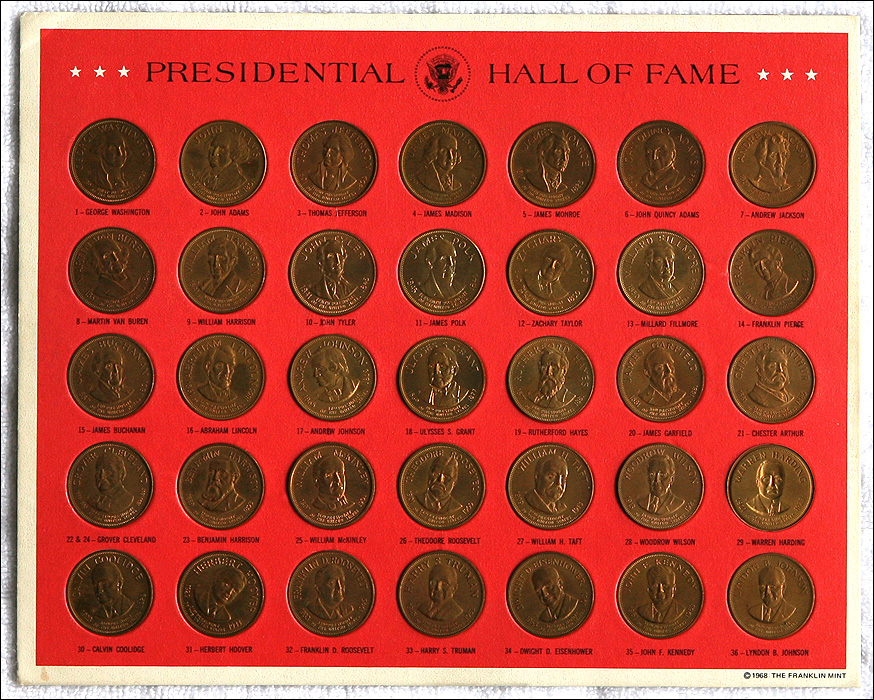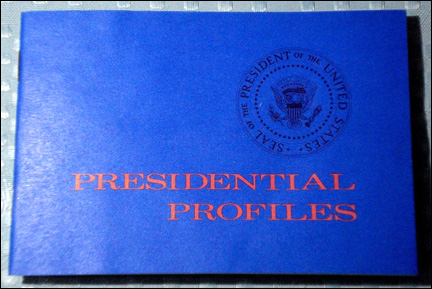The Crazy Shell's Mr. President Coin Game
 |
 |
|
This page is all about the prizes awarded in |
The Prizes
Cash prizes in Shell's Mr. President Coin Game were $1, $5, $50, $100, $500, $1,000, $2,500 and $5,000. The $2,500 prize was only available regionally at the beginning of the game (see game cards here).
In addition to cash, Shell's Mr. President Coin Game gave players the chance to win a beautiful set of presidential medals struck in bronze by The Franklin Mint. The presidential motifs on the medals were based on the work of sculptor Harold Faulkner, just like the aluminum game pieces, but the lettering and design was much nicer and looked great in bronze.
The bronze medal set, labeled 'Presidential Hall of Fame' went through five versions and was given as a prize in two separate Shell Oil Company promotions. The Franklin Mint produced 1,377,324 sets total in 1968 and 1969. About 600,000 sets went to winners in Shell's Mr. President Coin Game. Between 400,000 and 500,000 sets went to winners in Shell's Famous Facts & Faces Game. The rest were, apparently, sold by The Franklin Mint directly or used for other purposes.
All five versions of the prize were similar and came in a large envelope. The envelopes included the medals (sealed in a clear poly bag), a cardboard display board to mount the medals, and a small informational pamphlet with facts about each president. Most sets also came with a registration card that was intended to be mailed back to The Franklin Mint (so they could get you on their mailing list). There were four versions of the mounting board, four versions of the prize envelope, two versions of the pamphlet, three versions of the registration card, and two versions of the Lyndon B. Johnson medal. There was some mixing and matching of these components which created multiple packaging variations but there was basically five versions of the prize.
First version: The display board has thirty-five holes which are punched all the way through so that, when the medal is inserted, the entire reverse of the medal is visible. There is a clear plastic sheet glued to the back of the board so the medals do not fall out the back. It includes thirty-five medals; presidents George Washington through Lyndon B. Johnson. The Lyndon B. Johnson medal does not show his presidency dates. This 'plastic-backed' version is the least common.
Second version: The display board has thirty-five holes which are punched all the way through, then laminated to a thin white board with slightly smaller holes so the medals do not fall out the back. Therefore, you cannot see the entire reverse of the medals. It includes thirty-five medals; presidents George Washington through Lyndon B. Johnson. The Lyndon B. Johnson medal does not show his presidency dates.
Third version: The display board has a die-cut at the top with a removable insert for a thirty-sixth medal in anticipation of the next president to be elected. The printed title and the stars were moved to make room for the medal. It includes thirty-five medals; presidents George Washington through Lyndon B. Johnson. The Lyndon B. Johnson medal does not show his presidency dates.
Fourth version: The fourth version was issued after President Nixon was elected. The mounting board now has a hole at the top with '37- Richard M. Nixon' printed under it and the Richard M. Nixon medal is included for a total of thirty-six medals. Neither the Lyndon B. Johnson medal nor the Richard M. Nixon medal show their presidency dates.
Fifth version: Same as the fourth version except it includes a Lyndon B. Johnson medal which shows his presidency dates.
| Below: Presidential Hall of Fame, Mounting Board Version One. The Seal of the President of the Unites States is printed at the top with no die-cutting around it. The holes are punched all the way through the board, the 1968 copyright in the bottom-right corner of the board is printed using a large font, and the back of the board has a sheet of plastic glued to the board to keep the medals from falling out the back. |
 |
 |
| Below: Presidential Hall of Fame, Mounting Board Version Two. The Seal of the President of the Unites States is printed at the top with no die-cutting around it. The 1968 copyright in the bottom-right corner of the board is printed using a large font. It is laminated to a thin board with smaller holes to keep the medals from falling out the back. The white rings of the smaller holes can be seen from the front. This prevents viewing the entire reverse of the medals. |
 |
 |
Below: Presidential Hall of Fame, Mounting Board Version Three. The Seal of the President of the United States is printed at the top with die-cutting around it creating a removable disk so a thirty-sixth medal can be mounted. The 1968 copyright in the bottom-right corner of the board is printed using a small font. |
 |
Below: Presidential Hall of Fame, Mounting Board Version Four. A thirty-sixth hole at the top has '37 - Richard M. Nixon' printed under it. |
 |
Below: Prize Envelope Version One. The envelopes that contained the Presidential Hall of Fame prize changed over time. The first version has 'complete 35-piece' printed on it and references Shell's Mr. President Coin Game. The font and design is very simple. Version One envelopes contained a Version One mounting board, 35 medals and a Version One informational pamphlet. |
 |
Below: Prize Envelope Version Two. This version has 'complete 35-piece' printed on it and references Shell's Mr. President Coin Game. The paper is white and the font and design is fancy. Version Two envelopes contained 35 medals and either a Version Two or Version Three mounting board. It also contained a Version One informational pamphlet. |
 |
Below: Prize Envelope Version Three. This version does not reference how many medals are included. It only says 'a complete solid bronze collector's set.' It does not reference Shell's Mr. President Coin Game. Instead it says 'Shell's Coin Game.' Version Three envelopes contained a Version Four mounting board and 36 medals: |
 |
Below: Prize Envelope Version Four. This version was created by taking a Version Three envelope and pasting a piece of paper over the lower paragraph. Version Four envelopes contained a Version Four mounting board and 36 medals. On the example below the pasted paper piece was not centered over the paragraph which left a little text exposed on the right side - sloppy work! |
 |
Below: Presidential Profiles Pamphlets. Versions One and Two have the same cover and title page. | |
 | |
Below: Pamphlet Version One (left) contains a page for Lyndon B. Johnson and the inside of the back cover is blank. In Version Two (right), the Lyndon B. Johnson page is reformatted and an informational section for Richard M. Nixon is printed on the inside of the back cover. | |
 | |
Below: Three different Registration Cards. Version Three (right) does not mention a future medal and was included only with Version Four boards that had 36 medals. | |
 | |
Below: Lyndon B. Johnson Medals. Version One (left) does not show his presidency dates. Version Two (middle) shows his presidency dates and the Franklin Mint hallmark was moved slightly lower. A typical reverse is shown on the right. |
 |
Below: Sealed Poly Bag of Medals. This 36-medal bag contains an L. B. J. medal that shows his presidency dates and a Richard M. Nixon medal. This was the last variation of the set and it was only included with Version Four boards. |
 |
| Because there are two versions of the Lyndon B. Johnson medal, The Franklin Mint struck a total thirty-seven different bronze medals which, technically, comprises a complete set. All of the presidential medals show The Franklin Mint hallmark on the obverse. For some presidents, the hallmark is found in different positions on the medal (shifted very slightly). This indicates there was more than one working die produced for each president, and the hallmark was added by hand. So now you know more about the Mr. President Coin Game than the average person. Click here to see the main game page. Click here to see the game card page. Click here to see the newspaper page. |





